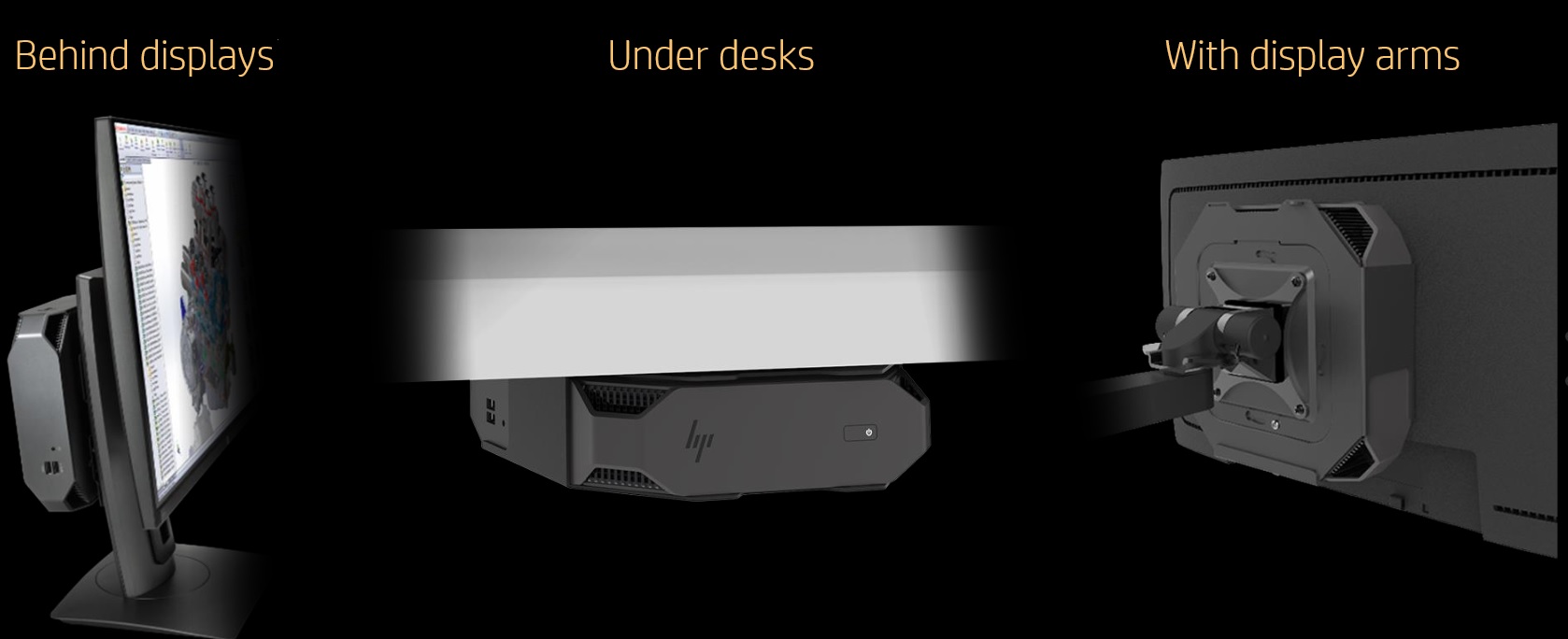HP Introduces The Z2 Mini G3 (Updated)
At Autodesk University in Las Vegas, HP introduced the HP Z2 Mini G3, a mini PC with a workstation-class Nvidia Quadro GPU that supports Intel Xeon E3-1200v5 CPUs.
The small form factor (SFF) PC measures only 8.5 x 8.5 x 2.28 inches, which is decidedly larger than a device such as an Intel NUC, but it’s comparable to many other mini PCs that don’t house discrete graphics. The Z2 Mini is one tenth the size of a traditional workstation tower, and about one fifth the size of HP’s Z240 SFF workstation PC. Furthermore, the Z2 Mini is (on paper) twice as powerful as the aforementioned mini PCs.
The Z2 Mini supports Intel Core i3, i5 and i7 processors, in addition to Xeon E3 processors. It also supports up to 32GB of DDR4 SO-DIMM memory, and the unit can be equipped with Nvidia Quadro M620 graphics with 2GB of memory. It has both a PCIe M.2 connector as well as space for a 2.5” hard drive, and the M.2 slot is positioned so that it can benefit from the cooling offered by the GPU cooler.
The Z2 Mini G3 was designed with airflow in mind, to keep both the CPU and GPU cool while running quietly. The heat vents on the corners of the machine are even designed to resist blockage caused by loose papers or desk clutter.
The company claimed the new Z2 Mini is 63% quieter than a comparable HP business-class mini PC. HP also boasted about the rigorous testing the Z2 Mini G3 endured, receiving three times the amount of testing hours that the company’s business PCs do. At launch, the HP Z2 Mini G3 workstation has already received 20 application certifications at launch.
The HP Z2 Mini G3 can be set on top of or under a desk, mounted directly behind a display, or on a VESA arm between the arm and the rear of the monitor. The Z2 Mini G3 saves space by being overtly unobtrusive, so that it can certainly just disappear on your desk. To that end, it supports remote power on from the keyboard or mouse, because the system is designed to be tucked away.
The HP Z2 Mini G3 comes in Entry and Performance models. The largest differences between the two is the lack of a dedicated GPU in the Entry model and the back panel--the Entry model has three DisplayPort interfaces and two USB 3.0 Type A connectors, whereas the Performance version adds another DisplayPort (for a total of four) and two USB 3.1 Type-C (Gen 1) ports. Both feature another two USB 3.0 Type-A ports on the side, and there is a provision to add a conventional serial port to the unit, which could be useful for businesses that still rely on older equipment.
Get Tom's Hardware's best news and in-depth reviews, straight to your inbox.
HP expects that the small, light, quiet Z2 Mini G3 will be popular in the design and CAD market segments, where an ever-increasing number of users are still migrating from 2D CAD programs to 3D applications. However, the financial markets and the medical segment could also significantly benefit from the Z2 Mini’s feature set. The HP Z2 Mini G3 workstation is expected to be available starting in December at $699.
Update, 11/15/2016 8:55pm CT: A change was made to clarify the storage capacity and GPU options of the HP Z2 Mini G3.
| Product | HP Z2 G3 Mini Workstation |
|---|---|
| Processor Options | - Intel Xeon E3-1200v5 Processors- Intel Core i3/i5/i7 Processors |
| Chipset | Intel C236 |
| Memory Capacity | Up to 32GB (2x SODIMM) |
| Graphics | Nvidia Quadro M620 2GB (Performance Model) |
| Storage Options | - Up 1TB 2.5" SATA- 512GB HP Z Turbo Drive (M.2 SSD) |
| Ports | - USB 3.1 Type-C (Gen 1) x2- USB 3.0 x4 (1 Charging) |
| Networking | - Gigabit LAN- Wireless AC w/Bluetooth (Optional) |
| Power Supply | 135W |
| Dimensions | 8.5 x 8.5 x 2.28 inches |
| Weight | Starting at 4.5 lbs. |
-
Draven35 Reply18869616 said:Quadro is such a ripoff...
And yet, a Quadro does outperform a GeForce in workstation applications. -
memadmax "And yet, a Quadro does outperform a GeForce in workstation applications."Reply
Only in VERY certain specific applications and just barely.
99% of the rest of what you do with a video card in a workstation environment can be done faster and cheaper with a TitanXP, and if one TitanXP doesn't cut it, you can scale up two or more and STILL be cheaper.
In the end, the price/performance ratio is absolutely insane for a quadro that only shines on a couple of applications. You could easily save $3,000 or more by just grabbing 2 or more TitanXps...
Linustechtips showed the carnage... -
Draven35 Reply18871579 said:"And yet, a Quadro does outperform a GeForce in workstation applications."
Only in VERY certain specific applications and just barely.
99% of the rest of what you do with a video card in a workstation environment can be done faster and cheaper with a TitanXP, and if one TitanXP doesn't cut it, you can scale up two or more and STILL be cheaper.
In the end, the price/performance ratio is absolutely insane for a quadro that only shines on a couple of applications. You could easily save $3,000 or more by just grabbing 2 or more TitanXps...
Linustechtips showed the carnage...
We tested them here several years ago and the low end Quadros were matching the performance of the high end game cards.
Also, that Titan isn't supported by something like Solidworks.
